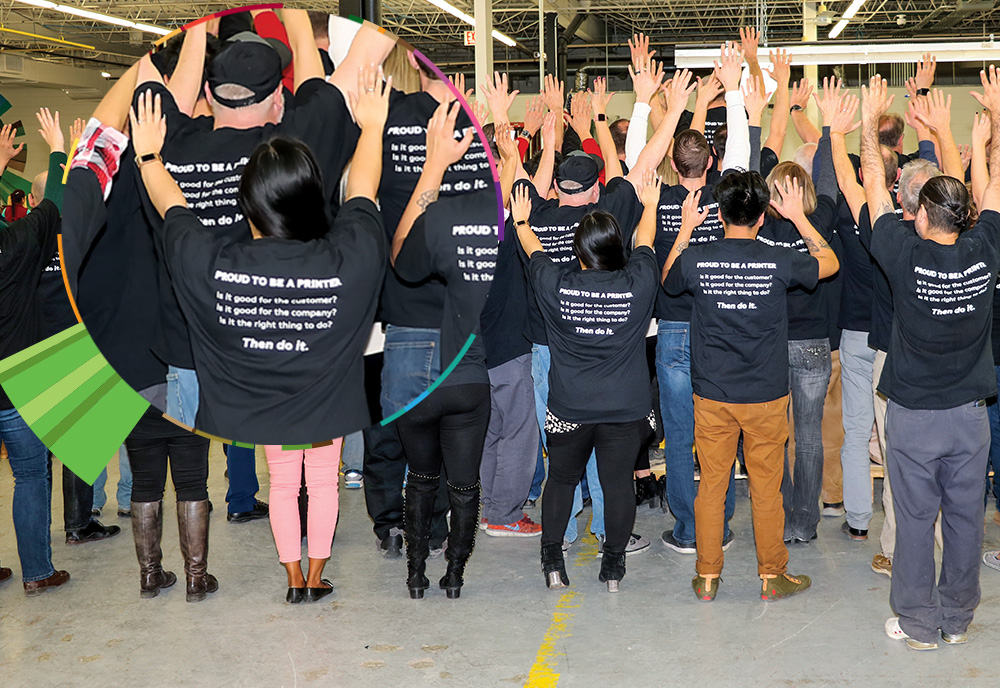She’s remaking the Quantum Group by asking questions — lots of them.
By Cheryl Kahanec
[stag_dropcap font_size=”100px” style=”normal”]A[/stag_dropcap]t Quantum Group — the digital printing, direct mail, and custom communications company in the greater Chicago area where I serve as CEO — we take ownership not just of the quality of a printed page, but the actual content on it. In an effort to make sure that the final product our customers deliver to their customers is the best and most effective it can be, we get involved very early in the content-creation process — long before words and images are ready to be printed.As a printer, we have the production capabilities to create, print, and distribute print jobs. But Quantum also has the marketing know-how and technical expertise to help our clients shape and target the messages in their communications. It’s my strong belief that we need to make full use of these capabilities in order to gain — and keep — a competitive edge in
this industry.
I have found that there’s only one way to do this: By asking questions. Lots and lots of questions. Of both our customers and ourselves. And only when we are armed with the resulting information can we bring technology and automation to bear in a way that enables everyone to win.
“Let’s dispense with one notion. I’ve had people tell me that automation means having a limited or nonexistent relationship with your clients. People think technology is “cold and heartless” and see automation as some kind of threat. I heartily disagree.”
And on that note, let’s dispense with one notion. I’ve had people tell me that automation means having a limited or nonexistent relationship with your clients. People think technology is “cold and heartless” and see automation as some kind of threat. I heartily disagree. Automation helps us increase efficiency, accuracy, and turnaround time, as well as present more options to our customers. Getting them what they need quickly and accurately helps them improve their business. And that wins us better relationships, which in turn helps us become more profitable. The key for us is working with our clients as we develop new technology, rather than rationalizing that something we develop in a vacuum is what’s best for them.

We Ask Our Customers
We start and end with our customers — because, as we all know, their success ensures ours, and vice versa. The fact is, we can’t help our customers if we don’t thoroughly understand what they’re hoping to achieve. It’s not enough to know their end game — which is typically wanting their customer to take some kind of action in response to a printed piece. To get to the point where we know enough about a project that we can bring innovative solutions to bear, we ask these kinds of questions about our customer’s print project:
- Who does this piece or campaign need to speak to?
- How should we talk to these recipients?
- What do we say to them?
- When do we say it?
- How many different ways do we need to say it?
Once we understand these details, we work backwards to find the best way to make them happen — powered by technology.
Let me give you an example. One of Quantum’s clients, a luxury hotel and casino in Las Vegas, wanted to build up their loyalty program with more frequent, personalized communications to members. They had made a significant financial investment in new Customer Relationship Management (CRM) technology but hadn’t been able to leverage the data they had about their loyalty program members. One of their main concerns was accuracy in proofing these mailings. The last thing they wanted was a piece landing in someone’s mailbox with another person’s name on the targeted message. And, they wanted to provide offers that their loyalty members had a high likelihood of using. Once we understood their objectives, we conceived the first iteration of what we call Q Dynamic.
Q Dynamic is a rules-based system that allows our more data-savvy customers to integrate their CRM with a database of templates and images, enabling them to create highly specific and targeted mailing campaigns. Within the system, they can create rules. For example, this customer could decide: If the casino has a male loyalty program member between the age of 40 and 60 who has not visited in 12 months, but spent $5,000 on his last stay, send him an offer with a 30 percent discount off his next stay. For a female loyalty program member who won $1,500 on the blackjack table three months ago, send a mailing with blackjack images and a voucher for $50 at the blackjack table on her next visit. Q Dynamic houses the images, coupons, and textual messages that can be combined in a piece depending on the rules and personas the customer defines. The level of personalization possible is extraordinary.
With this resource at its disposal, the hotel and casino sent over 350,000 pieces of customized direct mail, with 97.2 percent of it landing in the mailboxes of its loyalty program members within three days. Ultimately, the campaign yielded a 20 percent redemption rate — members cashing in on their loyalty rewards. This achieved the customer’s goal and exceeded their expectations.
We Ask Ourselves
I said before that we pose questions to our cus-tomers, but also to ourselves. Every single time we are faced with a decision — to create a tool, integrate third-party technology, or implement an aspect of automation (and the list goes on), we ask ourselves a set of three critical questions:
1 – Is it good for the customer?
Is it going to help the customer achieve their goal? Are they going to be happy with the result? Will it help their customer make a positive buying decision? Will it improve our customer’s business? This is always the first set of questions.
2 – Is it good for our company?
Is it sustainable and scalable? Can we do it again? Can we do it with other clients? Because this is what we’re trying to do with technology and automation — reuse it across multiple applications. And this leads to the paramount question: Is it going to be profitable for us?
3 – Is it the right thing to do?
If I’ve answered yes to the first two, I’m probably going to answer yes here. Of course “It’s the right thing to do” if it helps meet our customers’ goals faster and more accurately, and helps us do our job more efficiently. If I answer yes to all three questions, in this order, then we do it.
We conceptualized and built the Q Dynamic platform in partnership with this customer to meet their specific needs, but we did it with a clear awareness (confirmed by our three questions) that it would be valuable to other customers as well. Since this pilot project, we have integrated Q Dynamic into the workflow process of over 30 other customers.
The staff at Quantum has fully embraced my three-question philosophy. I continuously share it in meetings, emails, and presentations. I held a company-wide town hall and made T-shirts that said, “Proud to be a printer,” on the back, along with the three questions. Guided by these critical questions, we’re all moving in the same direction.
Here’s another example — in this case, of using automation to increase our output speed and efficiency. One of our clients, Circassia Pharmaceuticals, wanted to revamp their marketing efforts around their asthma management drug Tudorza. They had a new marketing team in place, and they needed a partner for the day-to-day challenge of delivering marketing collateral to their sales teams in the field. Their goal was to free up their onsite marketing staff, while providing the sales teams with an easy way to order these materials. The answer had to be efficient and cost-effective. After gaining a thorough understanding of these needs, we developed our Q Compass solution.
Q Compass is a customized web storefront where our clients can order preprinted material or request print-on-demand work with or without personalization. The site allows customers to personalize templates that strictly adhere to their brand rules, allowing the use of approved elements via drop-down menus and style sheets. Certain elements are locked down — say, brand colors and legal copy — and others can be selected from approved options — like text, images, and background colors. Think of it like InDesign with training wheels. Behind the curtain, that order is converted into an automated print job that moves through Quantum’s plant with minimum possible human touches.

The Q Compass storefront can be used for simple applications, such as ordering pre-printed materials, to more complex tasks like creating customized branded material in real time. The solution, which Quantum deployed in just six weeks, enabled Circassia to reduce waste and cut costs while ensuring optimal quality for their collateral. Now their sales teams in the field can have brand-approved materials delivered in just three days, while the creative and marketing staff stays focused on other initiatives.
By asking ourselves, “Is it good for the customer?” and “Is it good for our company?,” our team was able to implement technology in a way that produced game-changing results for our customer and enhanced our relationship with them. We then customized the Q Compass solution for another customer, pharmaceutical company BioDelivery Sciences International (BDSI). After one year of working with Quantum, BDSI reduced their materials production and management cost by 13 percent.
We also provide truly custom integrations. We work our customers to take their digital images or pages, their name and address data, and other information about an order (the so-called “metadata”) and create massive mailings built on rules. The latest of these was a 700,000-piece mailing that printed and mailed in less than 40 hours from the time we received the first byte of data.
Value of Automation
As printers, we’re judged on different things today than we were in the past. We’re providing a more rounded service, and automation enables that. It allows us to be more nimble and efficient, and most importantly, it gives our customers more options. If you think about these examples, there are so many moving parts. To manage these manually would take forever. Automation helps us do it — to produce, as we say, “one of millions, not millions of one.” We can produce a million different pieces that all have some level of personalization on them, wherein each one is meant for one individual. Automation is the only way you can do that efficiently.
And then there’s internal use of automation for process improvement — and that also benefits our customers. In the manufacturing environment, by nature of the beast, automation enables us to improve something we’re already doing. So if I take something that is moved from one process to another by hand and I can find a way to do that without touching it, I have an immediate improvement. I’ve eliminated a step that can cause a mistake. And I’m now doing two functions concurrently instead of two functions consecutively. That’s automation.
We’re always on the lookout for ways to automate. Right now, we’re working to solve a challenge for a customer that wants to utilize a barcode on a photo-centric mailpiece without detracting from it. So we went out and found software that will create an invisible barcode. We presented it to the customer, who saw it as a great solution, but we didn’t stop there. We showed it to our sales reps, who believed they’d have other interested customers. What we’re discovering now is that our customers have more uses for this technology than we expected. Meanwhile, I’m looking at ways to use it internally for job processing, to improve the way we track costs and quality assurance. We’re developing things like this every day. It’s exciting.
Double-Digit Growth
Asking probing questions — and then acting on what we find — is a simple but highly effective approach that’s helping our clients save money and be more effective. It’s also helping Quantum grow. We reached our best-ever monthly sales number in October 2018. And then we beat that number in November 2018.
Ten years ago, like almost everybody else in the industry, our company was impacted by the economic recession. But over the last several years, we’ve achieved consistent, incremental growth. Last year, we reached 10 percent growth. This year, we’ll hit 15 percent. We’re doing well enough on an annualized basis that I see double-digit growth going forward. My goal is to double the size of the company within five years. In an environment where five percent growth is better than average, we’re proud of these numbers and the work we’ve put in to achieve them.
“Last year, we reached 10 percent growth. This year, we’ll hit 15 percent. We’re doing well enough on an annualized basis that I see double-digit growth going forward. My goal is to double the size of the company within five years.”
Late in 2018, we picked up a new customer in a win that affirmed our efforts and approach. A major retail photo décor company signed on with us, even though we had made our pitch late in their decision-making process. Our innovative use of technology and automation, combined with our business philosophy, proved to be the deciding factors. This was clear during the company’s tour of our plant, where their questions zeroed in on our approach to customer relationships and the way we empower our staff to make the right decisions at all levels of the company. The CEO later shared with me that this is exactly what he and his team were looking for in a partner. It was a great way to start the new year.
Cheryl Kahanec is CEO of Quantum Group, in suburban Chicago. She has more than 35 years of experience in the print and marketing communications industry. Connect via kahanec@leadingprint.org.
Other recent articles

The Vanishing

Weighing In

We’re OK

The Guide

By The Numbers

